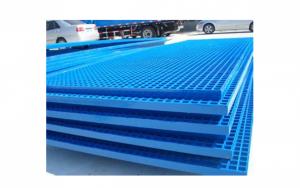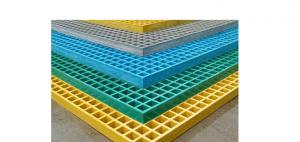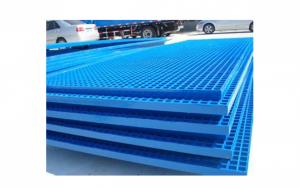FRP Molded Grating, Fiberglass Grating, Plastic Grating Floor with Best Quality/Good Shape
- Loading Port:
- China main port
- Payment Terms:
- TT or LC
- Min Order Qty:
- 100 m²
- Supply Capability:
- 5000000 m²/month
OKorder Service Pledge
OKorder Financial Service
You Might Also Like
Introduction
FRP Molded Grating is a structural panel which uses high-strength E-Glass roving as reinforcing material, thermosetting resin as matrix and then casted and formed in a special metal mold. It provides properties of light weight, high strength, corrosion resistance, fire resistance and anti-skid. FRP Molded Grating is widely used in oil industry, power engineering, water & waste water treatment, ocean survey as working floor, stair tread, trench cover, etc. and is an ideal loading frame for corrosion circumstances.
Feature
Corrosion Resistance
- Electrical Insulating
Aging Resistance
Specification
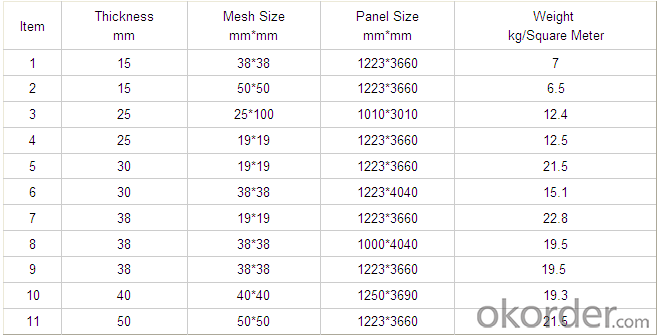
Advantage
coated with prevent aging layer
excellent insulating performance
- easy installation
Application
- Corrosive chemical industry equipment around the fence
All kinds of building maintenance section
FAQ
1. How's the payment?
Telegraphic Transfer(T/T) or Letter of Credit(L/C)
2. Do You Arrange Shipment?
Yes, dear esteemed customers, for FOB or CIF price, we will arrange shipment for you. For EXW price, clients need to arrange shipment by themselves or their agents.
3. How is the package?
Usually, we arrange the standard out-package for exporting.
PROCESS
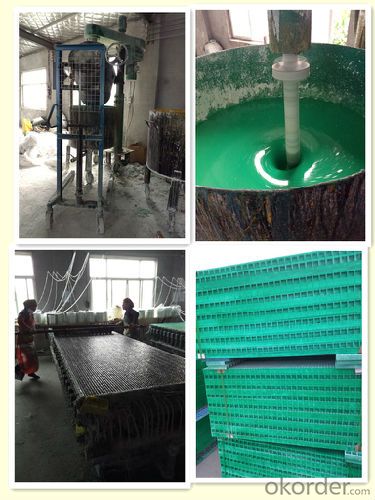
FACTORY
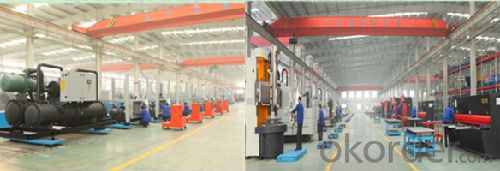

- Q:Can FRP pultrusion profiles be used in electrical or telecommunications applications?
- Yes, FRP pultrusion profiles can be used in electrical or telecommunications applications. FRP (Fiber Reinforced Polymer) pultrusion profiles have excellent electrical insulation properties and are resistant to corrosion, making them suitable for use in electrical and telecommunications infrastructure. Additionally, their light weight, high strength, and design flexibility make them a desirable choice for applications such as cable trays, support structures, and enclosures in these industries.
- Q:Are FRP pultrusion profiles resistant to ultraviolet radiation?
- FRP pultrusion profiles possess inherent resistance to ultraviolet (UV) radiation. This is due to the utilization of materials like fiberglass and resins in FRP profiles, which naturally offer UV resistance. The manufacturing process involves impregnating reinforcing fibers with a UV-resistant resin matrix and subsequently curing them. This combination of materials and production technique guarantees that FRP pultrusion profiles can endure extended exposure to UV radiation without significant deterioration or loss of mechanical properties. Consequently, FRP pultrusion profiles are widely employed in outdoor sectors like construction, infrastructure, and marine industries where UV resistance is imperative. Nevertheless, it is crucial to acknowledge that the level of UV resistance may vary depending on the specific composition of the FRP profile and the quality of the manufacturing process. Therefore, it is always advisable to refer to the manufacturer's specifications and guidelines for the particular product being used to ensure its suitability for UV-exposed environments.
- Q:Are FRP pultrusion profiles resistant to seismic activity?
- FRP (Fiber Reinforced Polymer) pultrusion profiles are known for their high strength-to-weight ratio and excellent mechanical properties. However, when it comes to seismic activity, their resistance depends on various factors. In general, FRP pultrusion profiles can exhibit good resistance to seismic activity due to their inherent properties. The composite materials used in their construction, such as fiberglass and resin, offer high tensile strength and stiffness, making them capable of withstanding dynamic loads caused by earthquakes. Moreover, FRP pultrusion profiles have been extensively tested and proven to possess excellent fatigue resistance. This property is crucial during seismic events as structures are subjected to repeated dynamic loading. The ability of FRP profiles to withstand cyclic loading without suffering from fatigue failure significantly enhances their seismic resistance compared to traditional materials like steel or concrete. Another advantage of FRP pultrusion profiles in seismic activity is their lightweight nature. Their low weight reduces the overall mass of the structure, resulting in lower seismic forces. This weight reduction can lead to reduced seismic responses and less damage during an earthquake. However, it is important to note that the seismic resistance of FRP pultrusion profiles can be influenced by various factors. These include the design and quality of the profiles, the connection details, and the overall structural system in which they are used. Proper engineering and design considerations must be taken into account to ensure optimal performance and seismic resistance. In conclusion, FRP pultrusion profiles have the potential to offer good resistance to seismic activity due to their high strength, stiffness, and fatigue resistance. However, their performance in seismic events depends on various factors, and careful design and engineering practices are essential to maximize their seismic resistance.
- Q:Can FRP pultrusion profiles be customized according to specific requirements?
- Yes, FRP (Fiber Reinforced Polymer) pultrusion profiles can be customized according to specific requirements. Pultrusion is a manufacturing process that involves pulling continuous fibers through a liquid resin bath, then through a heated die to cure the resin and form the desired shape. This process allows for great flexibility in design and customization. The customization options for FRP pultrusion profiles include various dimensions, shapes, colors, and surface finishes. The dimensions can be tailored to meet specific length, width, and thickness requirements. The shapes can range from basic geometries like rectangular or round profiles to more complex designs with custom cross-sections. In terms of color, FRP pultrusion profiles can be pigmented during the manufacturing process to achieve the desired color or can be painted or coated afterwards. This allows for matching specific color requirements or ensuring compatibility with existing structures or products. Furthermore, surface finishes can be customized to achieve desired properties such as increased slip resistance, UV resistance, or fire resistance. Surface treatments like sanding, coating, or adding special additives can be applied to meet specific performance requirements. Overall, FRP pultrusion profiles offer a high level of customization to meet specific project or application needs. They are versatile, lightweight, corrosion-resistant, and have excellent strength-to-weight ratios, making them suitable for various industries such as construction, transportation, infrastructure, and aerospace.
- Q:How do FRP pultrusion profiles perform in electrical grounding systems?
- FRP pultrusion profiles have demonstrated promising performance in electrical grounding systems, showcasing their potential. These profiles consist of a combination of fibers, such as glass or carbon, and a polymer resin matrix. This unique composition provides them with exceptional attributes, including high strength, durability, and resistance to corrosion. One noteworthy advantage of FRP pultrusion profiles in electrical grounding systems lies in their remarkable electrical insulation properties. Unlike metals, which conduct electricity, FRP profiles possess a significantly high resistance to electrical current. This aspect renders them ideal for applications where electrical isolation is paramount. By doing so, they effectively mitigate the risks associated with electrical shock hazards and diminish the potential for short circuits. Furthermore, FRP pultrusion profiles offer superior mechanical strength while remaining lightweight. Consequently, they are easy to handle and install, leading to reduced labor costs and time consumption. Additionally, these profiles exhibit resistance against UV radiation, chemicals, and moisture, ensuring their long-term performance and durability across various environmental conditions. Another advantageous attribute of FRP pultrusion profiles pertains to their corrosion resistance. Unlike metals, which are susceptible to rust and deterioration over time, FRP profiles remain immune to corrosion. This quality renders them highly suitable for deployment in harsh or corrosive environments, guaranteeing the longevity and reliability of the electrical grounding system. Moreover, FRP pultrusion profiles exhibit non-magnetic properties, presenting an advantage in situations where minimizing or eliminating magnetic interference is crucial. This characteristic effectively prevents any disturbances to sensitive electrical equipment, thereby ensuring accurate electrical measurements. In conclusion, FRP pultrusion profiles offer a multitude of advantages in electrical grounding systems. Their exceptional electrical insulation properties, impressive mechanical strength, corrosion resistance, lightweight nature, and non-magnetic characteristics make them a reliable and efficient choice for guaranteeing the safety and reliability of electrical grounding.
- Q:Can FRP pultrusion profiles be used in the construction of theme park rides?
- Yes, FRP pultrusion profiles can be used in the construction of theme park rides. FRP (Fiber Reinforced Polymer) pultrusion profiles are known for their high strength-to-weight ratio, corrosion resistance, and durability, making them suitable for various structural applications. These profiles can be used to build ride components such as supports, beams, frames, and safety structures, providing a lightweight yet robust solution for theme park rides.
- Q:Can FRP pultrusion profiles be used in the production of electrical cabinets?
- FRP pultrusion profiles are certainly viable for incorporating into the manufacturing process of electrical cabinets. Their exceptional electrical insulating characteristics render them a fitting option for applications involving the creation of electrical cabinets. These profiles are non-conductive, thus granting insulation and safeguarding against electrical currents, ensuring the security of the electrical components encased within the cabinet. Furthermore, FRP pultrusion profiles boast a high strength-to-weight ratio, resistance to corrosion, and durability, making them a dependable choice for enduring electrical cabinets in diverse settings.
- Q:Are FRP pultrusion profiles resistant to chemicals used in power plants?
- Yes, FRP (Fiber Reinforced Polymer) pultrusion profiles are generally resistant to the chemicals commonly used in power plants. FRP composites are known for their excellent chemical resistance properties, making them suitable for a wide range of industrial applications including power plants. The specific chemical resistance of FRP pultrusion profiles can vary depending on the resin matrix used and the specific chemicals they are exposed to. However, in most cases, FRP pultrusion profiles are resistant to chemicals such as acids, alkalis, solvents, and corrosive gases commonly found in power plants. It is important to consult with the manufacturer or supplier of FRP pultrusion profiles to ensure that the specific resin matrix and formulation used meets the requirements for chemical resistance in a power plant environment.
- Q:Are FRP pultrusion profiles resistant to ultraviolet radiation?
- Yes, FRP (Fiber Reinforced Polymer) pultrusion profiles are typically resistant to ultraviolet (UV) radiation. The nature of the materials used in FRP profiles, such as fiberglass and resins, provides inherent UV resistance. These profiles are manufactured using a pultrusion process that involves impregnating reinforcing fibers with a UV-resistant resin matrix and then curing them. This combination of materials and manufacturing technique ensures that FRP pultrusion profiles can withstand prolonged exposure to UV radiation without significant degradation or loss of mechanical properties. As a result, FRP pultrusion profiles are commonly used in outdoor applications where UV resistance is essential, such as construction, infrastructure, and marine industries. However, it is important to note that the level of UV resistance can vary based on the specific composition of the FRP profile and the quality of the manufacturing process. Therefore, it is always recommended to consult the manufacturer's specifications and guidelines for the specific product being used to ensure its suitability for UV-exposed environments.
- Q:Can FRP pultrusion profiles be used in the construction of wastewater treatment tanks?
- Indeed, wastewater treatment tanks can effectively utilize FRP pultrusion profiles. These profiles are renowned for their exceptional strength-to-weight ratio, resistance to corrosion, and longevity, making them an optimal option for harsh environments such as wastewater treatment facilities. To manufacture FRP pultrusion profiles, continuous fibers like glass or carbon are drawn through a resin bath and subsequently through a heated die to attain the desired shape. This process yields profiles with consistent cross-sections and outstanding mechanical properties. In the construction of wastewater treatment tanks, FRP pultrusion profiles can serve various purposes. They can function as structural components, like beams, columns, and bracing systems, offering the necessary strength and rigidity to support the tank structure. Additionally, FRP profiles can reinforce concrete structures, bolstering their durability and resistance against chemical attack from the wastewater. Moreover, FRP pultrusion profiles can be engineered to endure the corrosive impact of the chemicals and gases found in wastewater treatment tanks. Unlike conventional materials such as steel or concrete, FRP exhibits a high resistance to corrosion, guaranteeing an extended service life and reduced maintenance expenses. Furthermore, FRP profiles provide advantages in terms of installation and transportation. They are lightweight, enabling easier handling and diminished labor requirements during construction. The modular nature of FRP profiles also facilitates swift assembly and disassembly, simplifying maintenance and modifications. Overall, incorporating FRP pultrusion profiles in the construction of wastewater treatment tanks offers numerous benefits, including superior strength, corrosion resistance, durability, and ease of installation. These advantages render FRP a dependable and cost-effective choice for wastewater treatment facilities.
1. Manufacturer Overview |
|
|---|---|
| Location | |
| Year Established | |
| Annual Output Value | |
| Main Markets | |
| Company Certifications | |
2. Manufacturer Certificates |
|
|---|---|
| a) Certification Name | |
| Range | |
| Reference | |
| Validity Period | |
3. Manufacturer Capability |
|
|---|---|
| a)Trade Capacity | |
| Nearest Port | |
| Export Percentage | |
| No.of Employees in Trade Department | |
| Language Spoken: | |
| b)Factory Information | |
| Factory Size: | |
| No. of Production Lines | |
| Contract Manufacturing | |
| Product Price Range | |
Send your message to us
FRP Molded Grating, Fiberglass Grating, Plastic Grating Floor with Best Quality/Good Shape
- Loading Port:
- China main port
- Payment Terms:
- TT or LC
- Min Order Qty:
- 100 m²
- Supply Capability:
- 5000000 m²/month
OKorder Service Pledge
OKorder Financial Service
Similar products
New products
Hot products
Related keywords
